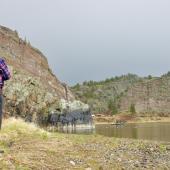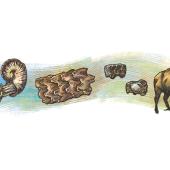Wild West Words: Geyser, Raven, & Powwow
GEYSER
The world’s most famous and viewer-friendly geyser is arguably Yellowstone National Park’s Old Faithful. Named for its relatively predictable eruptions, Old Faithful rockets a column of steam and boiling water 100-plus feet in the air approximately every ninety minutes.

Old Faithful has at least three hundred companion geysers in the Yellowstone area. All these dramatic eruptions are caused by volcanically heated, subterranean water shooting upward through rock channels in a kind of underground pressure valve.
Other such geothermal features are sprinkled around the world in New Zealand, Chile, Iceland, and Siberia. All are generically referenced as geysers, no matter where they’re found. What’s the story behind this term?
It comes ultimately from Old Norse, the language of the Vikings and their sagas. When Norse sailors began settling the island of Iceland in the 800s, they found a land of active geothermal and volcanic features. One was an impressive fountain that periodically shot a column of boiling water 200 feet high. The settlers called it Geysir, meaning, roughly, “the gusher,” from an Old Norse verb geysa, “to gush.” It was the first of such features described in a printed source and the first known to Europeans.
Borrowing the word in the late 1700s, English speakers turned it into geyser. This Norse-based term now refers generically to all spouting hot springs.
RAVEN
The words chickadee, killdeer and whippoorwill derive from human attempts to verbally imitate bird calls. The world over, birds are named for the sounds they make: there’s the chachalaca in Central and South America; the hoopoe throughout Eurasia and Africa; and the kookaburra laughs from its perches in Australia.
The word raven, at first blush, doesn’t appear to be a part of this onomatopoetic avian party. To our ears, the common raven, ubiquitous throughout the northern hemisphere, makes sounds that we describe as caws and croaks. But if we listen with the sensibility of some of our early linguistic predecessors, another sound emerges.
The modern word raven comes from the Old English hraefen, which is the way those speakers imitated the bird’s gutteral vocal patterns. In Old Norse, the bird’s name was hrafn, which amounted to a Viking onomatopoea. Over the centuries, the initial h-sound diminished, and the bird became a raven in modern English.
Its scientific name, corvus corax, reflects the common Greek term for the bird, korax, the croaker.
Just as humans fabricate words to copy the sounds ravens make, ravens can be taught to imitate human speech. Charles Dickens’ pet raven named Grip had an impressive English vocabulary. Not so Edgar Allen Poe’s bird, whose command of the language was restricted to the single ominous word nevermore.
POWWOW
Today, “powwow” is recognized the world over as a Native North American celebration of rhythm, regalia, song and dance. The word powwow originated in a relatively small region of the American East Coast, and did not always refer to a celebration of traditions.
The term was first recorded in English by Mayflower passenger Edward Winslow in his 1624 journal Good News from New England. The journal preserves Winslow’s observations on New World weather, food procurement, colony politics, and Native American customs.
Winslow describes his association with the indigenous Narragansett of present-day Rhode Island, and his rudimentary comprehension of the native’s “copious, large, and difficult” language.
One of the words Winslow learned was Powah, the title of a Narragansett shaman-healer. Winslow writes in his 1624 journal, “The office and duty of the Powah is... principally in... curing diseases of the sick or wounded.” The term showed up in later writings as pouwau, pawawe, pawwaw, and, ultimately, powwow. Linguists studying native East Coast languages trace powwow to a term meaning “one who dreams,” which suggests the mystical power of a healer.
By the early 1700s, the term was expanded by English speakers to include a gathering of Native people. English historian John Oldmixon wrote in his 1708 British Empire in America, “On the 22d of May, the Indians at the Wigwams, near the Fort, had a Powwow, or sort of Conjuring.”
The term accompanied westward expansions, alighting anywhere a conspicuous Native assembly involved feasting, drumming, dancing or incomprehensible religious ceremony.
A 21st century powwow is an indigenous celebration incorporating such modern amenities as amplified sound systems, evolving contest rules and generous prizes. Tribal affiliations notwithstanding, contemporary powwows borrow from an ancient Narragansett source-word meaning “one who dreams.”












Leave a Comment Here